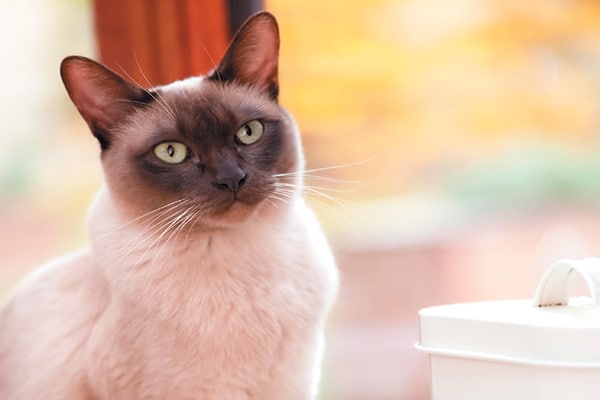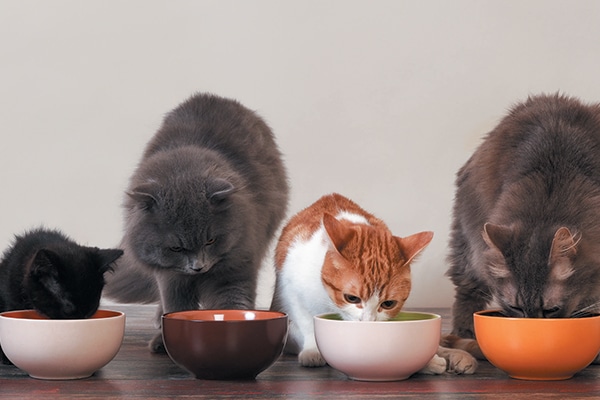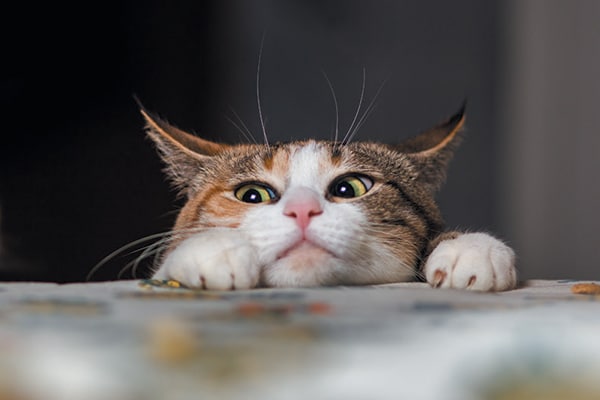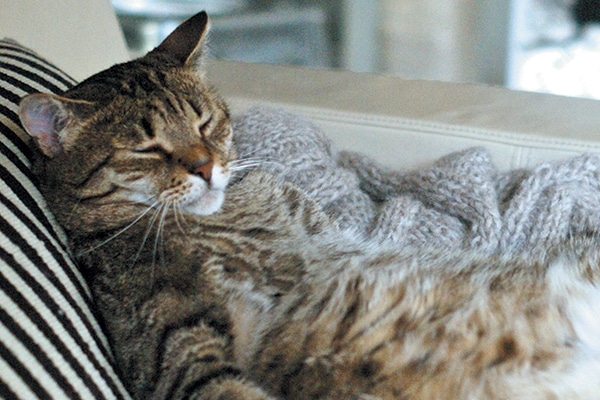Feline obesity is on the rise and can lead to serious consequences because an unhealthy weight can predispose a fat cat to various grave medical conditions and, ultimately, even a shorter life span. First, let’s take a quick cat food quiz to gauge your relationship with your cat and her food bowl. What is the No. 1 reason your cat is fat?
- Overfeeding your cat
- Free feeding your cat
- Giving your cat human food
- Giving your cat too many treats
And, which of the above have you been guilty of doing?
(It’s OK, we won’t divulge …) According to veterinarian Dr. Drew Weigner of the all-feline practice The Cat Doctor in Atlanta, Georgia, overfeeding is the main reason cats are fat. But free feeding, feeding human food and too many treats also contribute to weight gain. And many of us cat parents are guilty of all of the above!
Cats are fat because we’re feeding them too much

As cat parents, we have to be accountable. But there is no question that we share the blame with cats themselves because felines are great manipulators and know how to induce a guilt trip with their insistent head butting and meowing, holding us hostage over the food bowl and when it comes to dispensing treats.
Nathan A. Elam, Ph.D., a consulting nutritionist for Nutrition Service Associates and Inline Nutrition, who also advises Merrick Pet Care with regard to their feline formulas, explains that cats are instinctively programmed to get all they can when they can because the next opportunity may not be certain.
“Most cats, in fact, probably all cats, will consume more calories than necessary if you give them the opportunity,” Elam says. “Cats require a quality carnivore diet. The nutrient density of a high-quality cat food will provide adequate nutrition in small quantities. But, from a cat parent perspective, as caregivers, the adequate amount to maintain a healthy, active lifestyle does not appear to be enough.
“Controlled, measured feeding is the best management to avoid causing obesity. And when it comes to feeding guidelines on the label, all foods should provide good quantity guidance for desired weight outcomes based on the caloric density of the recipe,” he adds. Low-cal eats
However, Weigner points out that while all foods offer feeding guidelines, they are for the “average” cat. “I don’t consider any of my cats to be average! And the same goes for other cat parents out there,” he confesses. “The bottom line is, if your cat is overweight, she’s getting too many calories.
“So it’s a good idea to have a discussion with your veterinarian. And, because nowadays there are so many food choices, it’s a good idea to take the food your cat is currently eating with you [to the veterinarian] so that its daily suggested quantities can be tweaked to meet your cat’s needs.
“It’s not like cat parents aren’t aware that their cats are overweight. Often they try and address the issue by feeding a lower calorie diet.” Weigner recommends a prescription diet when helping your cat lose weight. “Veterinary prescription diets are the ‘real deal’ and are significantly lower in calories, so I use them frequently with great success.”
Weigner says to feed exactly the same volume of food of the prescription diet on the same schedule. “This is important,” he stresses, “as many clients feed more because it’s lower in calories, or they use dry prescription diets and canned regular food because they feel sorry for their cat, neither of which is effective.”
Weigner also highlights the importance of gradually switching to a new diet so the cat can slowly adapt to the food change. Finally, if a cat won’t eat one prescription diet, there are others, with different flavor options.
You have a fat cat because you feed him too many treats
The second reason cats are overweight is because they are getting too many treats.
“Treats are just that — a treat — a way to encourage desired behaviors when training, or most often to physically demonstrate love and affection,” Elam explains. “Unfortunately, treats are a source of calories that are seldom counted against daily nutritional requirements. Treats for pets can be a healthy addition to nutrient intake if they are regulated like a human mid-morning/afternoon snack and the calories are considered part of the daily caloric requirements. As a healthy addition to the diet, treats should account for 10 percent or less of the total caloric intake.”
Continue to feeding a grown cat like a kitten will make your cat fat
Kittens need a special enriched diet as they grow. However, feeding kitten food after a young cat’s growing stage can, in fact, set him up for obesity. Typically, most cats are fully grown around 6 months of age, but certain large breeds can continue growing up to one year.
“Feeding kitten food after that will definitely contribute to obesity,” Weigner says. “The best way to tell is to ask your veterinarian when your cat will become an adult. It’s often when all their adult teeth are in.” Multi-cats, multi-meals
Feeding multiple cats can be a challenge if they have different eating patterns. One may sit down and polish off a meal, and another may like to graze all day. Dominance issues also come into play in terms of who has control over the food bowls, with an aggressive eater polishing off food put down for housemates.
Encouraging cats to all become fixed-meal eaters will solve the problem as long as they are still fed under supervision and you manage the daily amounts.
Use tech to help your fat cat lose weight

The latest high-tech food bowls can be programmed to feed cats controlled amounts. They are the answer in multi-cat households. There are even bowls that can be programmed to feed several different cats in the household their daily allowance. (This just means that they have to take turns at the food bowl.) Others operate on a cat’s individual microchip. This means that the bowl will only open for a designated cat’s microchip.
High-tech food bowls are expensive, but they are definitely worth the investment. By feeding fixed amounts a day, it doesn’t matter whether the cat is a grazer or likes to polish off the meal in one go. And in the long term, it will cut down on vet bills to treat serious medical issues such as diabetes that can develop from overeating.
If your cat is a little heavier than your vet would like, try some of these simple tips. Also, next time your cat looks at you with those pleading eyes, instead of a treat, grab a cat toy and play with him. A longer life for your cat is the best treat ever.
Letting your cat eat from the table isn’t good, either

Allowing your cat to dine with you during mealtime encourages undesirable behaviors (especially when you have company over for dinner). And, unless you consume a strictly meat-based protein diet, the variety and inconsistency in fats, fibers and proteins in a typical human diet can lead to digestive irregularity and undesirable stool quality.
Cantaloupes for cats? This fruit can help a fat cat lose weight

Here’s the oddest weight control tip you’ll ever hear — from Dr. Drew Weigner. Inexplicably, many cats love cantaloupe, which has almost no calories and is quite safe to eat. It’s not like cats eat cantaloupe in the wild, but it’s a great alternative as a treat for an overweight cat.
Tell us: Do you have a fat cat?
Thumbnail: Photography ©Lulamej | Thinkstock.
Ziggy and Tory “work” as feline muses for Sandy Robins, an award-winning multimedia pet lifestyle expert, author and pet industry personality. They like to disrupt the workflow by playing fetch with wand toys and directing food operations in the kitchen. Learn more about Sandy at sandyrobinsonline.com.
Editor’s note: Have you seen the new Catster print magazine in stores? Or in the waiting area of your vet’s office? Click here to subscribe to Catster and get the bimonthly magazine delivered to your home.
Read more about cat food on Catster.com:








